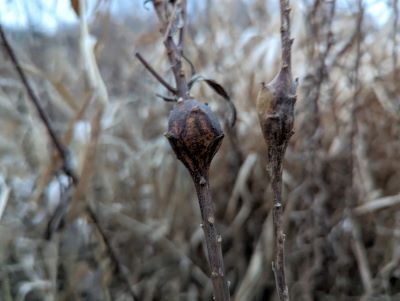
Good Natured: Goldenrod Galls Host a Diversity of Life
Last week we took a look into the life and times of little Eurosta solidaginis, the goldenrod gall fly. In case you need a refresher: A female deposits an egg that hatches into a larva, which then spends the summer feeding on plant juices inside its round, corky gall. In winter it hibernates and in spring it pupates, then *pop* it emerges and the cycle begins again. But…
There's always a but, isn't there? In this case, the catch is that goldenrod gall flies are insects--small creatures that live very big lives of drama and intrigue. Besides the constant threat of human interventions like stomping, swatting and spraying, members of Class Insecta must put up with a multitude of other intrusions, often by creatures that look very much like themselves.
These threats loom large for goldenrod gall flies, which might have 50% or more of their offspring extinguished by unwelcome guests. Roommates move in uninvited, and Freeloaders literally insert themselves in a variety of situations.
To fully understand their impacts, let's take a closer look at each of these broad categories of characters.
Although its common name, the tumbling ragdoll, makes its sound adorable, Mordellistena convicta is a Roommate of the worst kind. This beetle is a type of stem borer, meaning its larvae feed on plant tissues. That habit in itself is no problem, and in fact if they stuck with just stems and piths, these guys would pose no threat at all.
The thing is, they sometimes bore into the galls of goldenrod gall flies. Then, just like a Roommate I had for a short time in college, they eat the resident out of house and home. Sounds bad, doesn't it?
Well, it gets worse.
When that gall tissue runs out, the beetle larva turns into a carnivore and consumes the gall fly larva. And just like that, the Roommate becomes the Sole Tenant, and we have one less gall fly in the world.
This Eurosta population control continues when the Freeloaders show up. These small wasps aren't just parasites, they're parasitoids, which means they kill their hosts.
One species, Eurytoma obtusiventris, shows up right at the get-go, when the gall fly egg or teensy larva is still near where mama fly deposited it. Quick as a wink, the female wasp inserts her egg into the young fly and then…nothing.
Obtusiventris or, shall we say, Freeloader A, just hangs out inside the fly larva, biding its time as the immature fly feeds and grows. Then, when the baby fly is nice and plump, the wasp larva begins its own development--by feeding on the fly FROM THE INSIDE OUT. Freeloader A then overwinters in the gall it did absolutely nothing to produce and emerges in spring to begin the cycle anew.
When we said drama and intrigue, we weren't kidding. But what, there's more!
Freeloader B, E. gigantea, is a cousin of Freeloader A but with a different m.o. These females show up later in summer, when fly larva's gall is of substantial size. It might look impenetrable, but it's no match for the long ovipositor, or egg-depositing organ, of Freeloader B.
Inside the gall, Baby B quickly consumes the fly larva, then switches diets and starts feeding on the gall's inner walls. It remains ensconced through pupation, and emerges the following summer.
Thicker gall walls would seem a great solution to this parasitoid problem, but in solving one problem, bigger galls create another: They're exactly what chickadees, woodpeckers and other birds look for when they're out foraging in winter. Peck, peck, peck and another fly larva bites the dust.
These larva vs. larva conflicts have been going on for thousands of years, and will continue for thousands more. Meanwhile, though, there's another group of goldenrod-reliant insects living their own dramatic lives.
Elliptical gall moths, which you can think of as the Neighbors, live out their lives in similar fashion to the gall flies—drama and intrigue included! They have their own set of parasitoid wasps—a whopping 13 different species--plus a fungus and even a nematode to contend with.
What jumped out at me though was how the moth's caterpillar behaves inside the gall. It feeds on plant tissue and, like the gall fly larva, chews an exit tunnel it will use as an adult. But unlike the fly larva, the caterpillar plugs its exit with a bung—a truncated cylinder that can be pushed out, but not in. (Fellow consumers of beverages aged in oak barrels…you know what I'm talking about!)
Folks, this little glimpse into Solidago goldenrod stems only scratches the surface of the multitude of connections that lie within. Dozens, perhaps hundreds, of other gall-makers and their Roommates and Freeloaders can be found there, as well as in the leaves, flowers and roots. There's even evidence of speciation, that is, that these insects are evolving right before our eyes!
Before you right off goldenrod as just another plant or, worse, a weed, take a closer look at the diversity of life it hosts. Round galls, elliptical galls, bud galls, even galls-within galls. I kid you not, you'll have a ball!
Pam Otto is the outreach ambassador for the St. Charles Park District. She can be reached at potto@stcparks.org.

